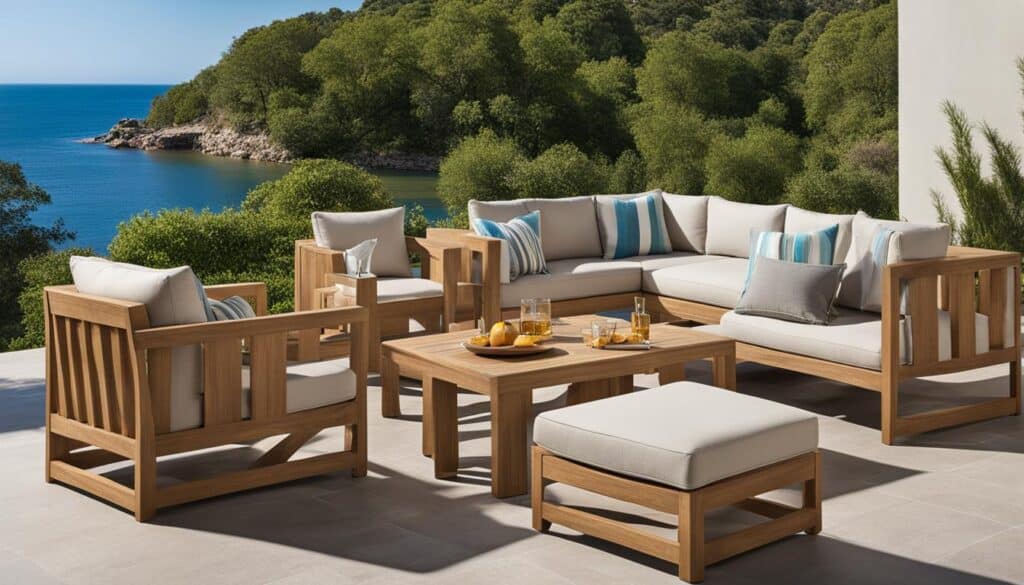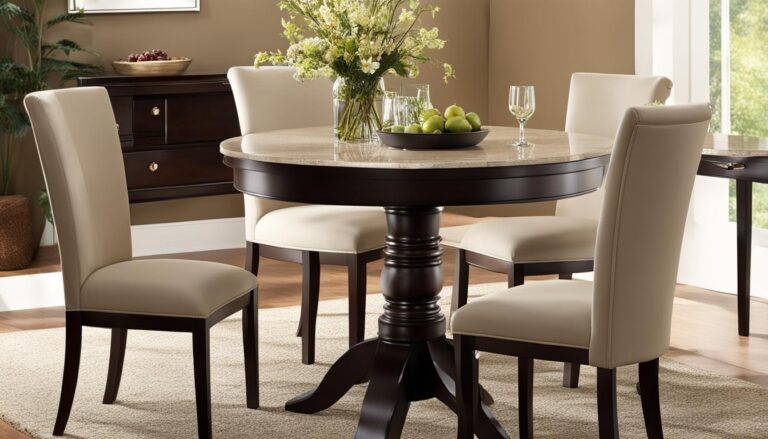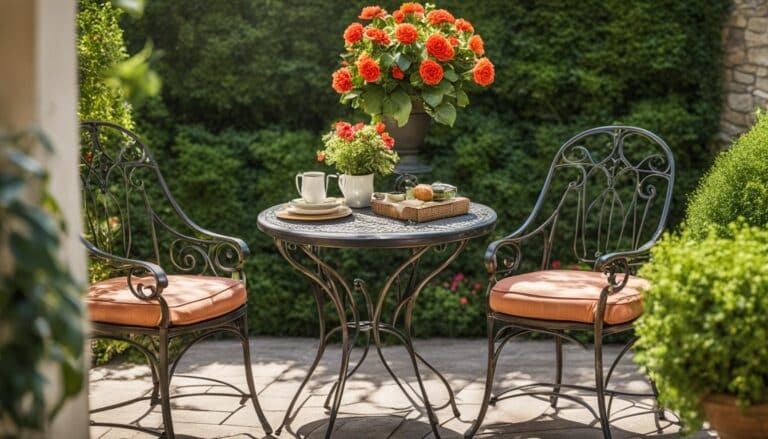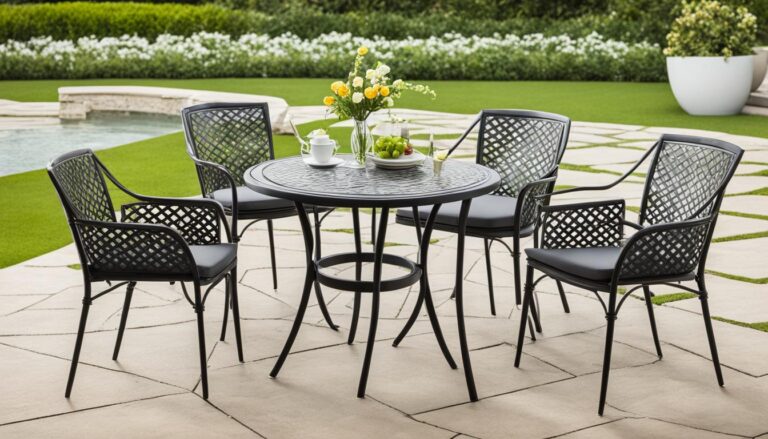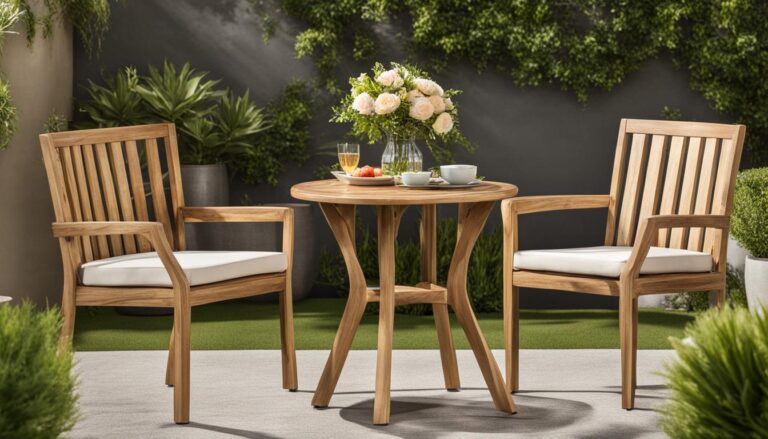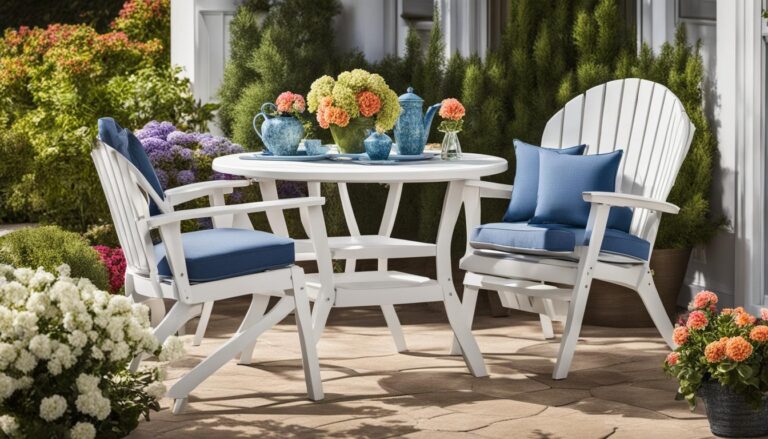When it comes to outdoor furniture, durability is key. You want furniture that can withstand the elements and stand the test of time. So, what type of outdoor furniture is the most durable? Let’s dive in and explore the options.
Whether you’re looking for long-lasting outdoor furniture or sturdy pieces that can handle whatever Mother Nature throws at them, it’s important to choose materials that can withstand the weather. To help you make an informed decision, we’ve gathered expert recommendations from various sources to highlight some of the most durable outdoor furniture options.
Key Takeaways:
- Choosing durable outdoor furniture is essential for longevity.
- Consider your climate when selecting materials for outdoor furniture.
- Popular materials for outdoor furniture include wood, teak, wrought iron, aluminum, wicker, stainless steel, recycled plastic, and high-pressure laminate.
- Outdoor upholstery materials also play a role in durability.
- Proper care and maintenance are crucial for extending the life of your outdoor furniture.
Consider Your Climate
When selecting outdoor furniture, it’s essential to consider the climate in your area. The weather conditions can have a significant impact on the durability and longevity of your outdoor furniture. Different materials have varying levels of resistance to the elements, and choosing the right one can help ensure that your furniture withstands the test of time.
Harsh Sun and High Temperatures
- Opt for materials like aluminum or stainless steel that have high heat resistance and won’t fade or warp in the sun.
- Consider furniture with UV-resistant finishes or coatings that offer extra protection against sun damage.
Humidity and Rain
- Choose materials that are resistant to moisture, such as teak or synthetic resin wicker, to prevent mold and mildew growth.
- Consider furniture with quick-drying properties, like polypropylene cushions, to avoid moisture buildup.
Freezing Temperatures and Snow
- Opt for materials like aluminum or wrought iron that are resistant to rust and won’t crack in freezing temperatures.
- Consider furniture that can be easily stored indoors during the winter months to protect it from extreme cold and snow.
By taking into account your specific climate, you can choose outdoor furniture that is better equipped to withstand the weather conditions in your area. This will ultimately contribute to the longevity and durability of your outdoor furniture investment.
Popular Outdoor Furniture Materials
When it comes to choosing outdoor furniture, there are various materials to consider, each offering its own unique advantages and disadvantages. Here are some of the most popular outdoor furniture materials:
1. Wood Outdoor Furniture:
Wood is a classic choice for outdoor furniture due to its natural beauty and durability. However, it does require regular maintenance, such as sealing and staining, to protect it from the elements. Popular wood options include teak, cedar, and pine.
2. Teak Outdoor Furniture:
Teak is highly recommended for outdoor use because it is resistant to water, rot, and insects. It has a natural oil content that helps it withstand harsh weather conditions, making it a durable and long-lasting choice.
3. Wrought Iron Outdoor Furniture:
Wrought iron is known for its strength and durability. It can withstand heavy winds and is resistant to rust when properly cared for. This material is often used for traditional or vintage-style outdoor furniture.
4. Aluminum Outdoor Furniture:
Aluminum is a lightweight and low-maintenance option for outdoor furniture. It is resistant to rust and corrosion, making it ideal for coastal areas. Aluminum furniture is available in a wide range of styles and finishes.
5. Wicker Outdoor Furniture:
Wicker furniture made from synthetic resin is weather-resistant, lightweight, and easy to clean. It can withstand outdoor elements without losing its shape or color. Wicker furniture is available in various styles and colors to suit any outdoor space.
6. Stainless Steel Outdoor Furniture:
Stainless steel offers a modern and sleek option for outdoor furniture. It is highly durable, resistant to rust and corrosion, and requires minimal maintenance. Stainless steel furniture is often used in contemporary outdoor designs.
7. Recycled Plastic Outdoor Furniture:
Recycled plastic furniture is a sustainable and eco-friendly choice for outdoor spaces. It is strong, durable, and resistant to moisture, mildew, and insects. This material is available in a wide range of colors and styles.
8. High-Pressure Laminate Outdoor Furniture:
High-pressure laminate provides a sleek and hardwearing option for outdoor furniture. It is resistant to scratches, stains, and UV rays. This material is commonly used for outdoor tables and countertops.
When selecting outdoor furniture, consider your personal style, budget, and the specific needs of your outdoor space. By choosing the right materials, you can create a beautiful and durable outdoor setting that will withstand the test of time.
Popular Outdoor Upholstery Materials
When it comes to outdoor furniture, choosing the right upholstery materials is essential for both comfort and durability. The right fabric can withstand the elements and enhance the overall aesthetic of your outdoor space. Here are some popular outdoor upholstery materials to consider:
Polypropylene Outdoor Upholstery
Polypropylene is a versatile and durable choice for outdoor upholstery. It is resistant to UV rays, mold, and mildew, making it perfect for outdoor use. This material is also quick-drying, which is ideal for areas with frequent rain or high humidity. Polypropylene upholstery is available in a wide range of colors and patterns, allowing you to customize your outdoor furniture to suit your style.
Acrylic Outdoor Upholstery
Acrylic fabric is another popular choice for outdoor upholstery. It is known for its fade resistance and ability to hold its color longer than other materials. Additionally, acrylic is mold and mildew resistant, making it a great option for areas with high humidity. This fabric is commonly used for cushions, pillows, and patio umbrellas.
Cotton Blend Outdoor Upholstery
Cotton blend fabrics offer a softer and more comfortable feel for outdoor furniture. They can provide a cozy and inviting atmosphere to your outdoor space. However, cotton blend upholstery may require finishes to make them more resistant to water and fading. It is important to properly care for and maintain cotton blend upholstery to ensure its longevity.
Polyester Outdoor Upholstery
Polyester is a durable and water-resistant fabric that is commonly used for outdoor upholstery. It resists tearing and damage from water exposure, making it suitable for outdoor use. However, prolonged exposure to direct sunlight can cause polyester to fade over time. Consider using polyester upholstery in shaded areas or use outdoor furniture covers to protect it from the sun.
Vinyl Outdoor Upholstery
Vinyl is one of the most durable options for outdoor upholstery. It is highly resistant to water, stains, and UV rays. Vinyl upholstery is easy to clean and maintain, making it a practical choice for outdoor furniture. However, it may not be as breathable as other materials, so it’s important to consider ventilation when using vinyl upholstery.
Choosing the right upholstery materials for your outdoor furniture can significantly impact its durability and overall appeal. Whether you opt for polypropylene, acrylic, cotton blend, polyester, or vinyl, make sure to consider your specific needs and preferences. With the right upholstery, your outdoor furniture can withstand the elements and provide a comfortable and inviting outdoor space for years to come.
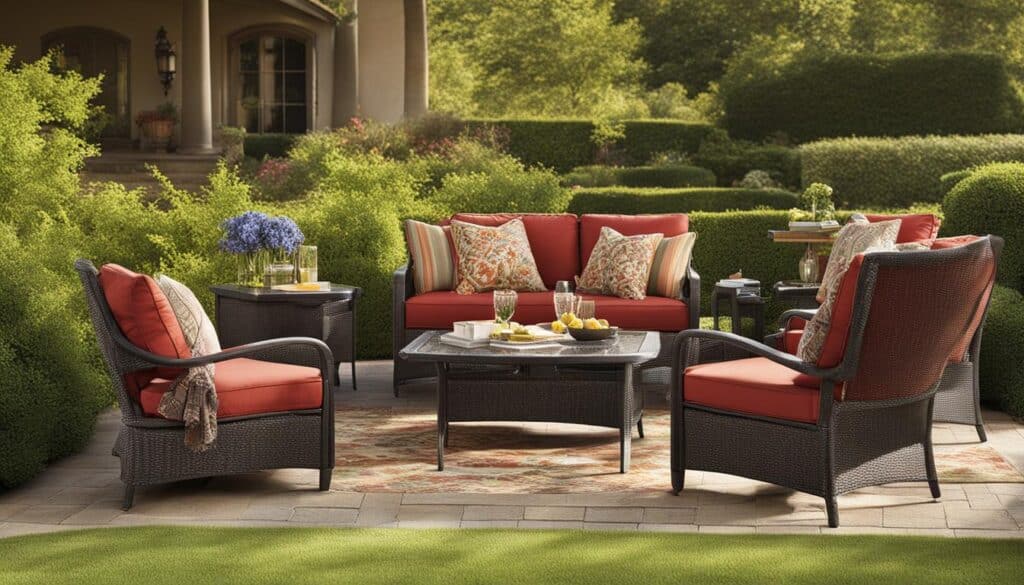
Conclusion
When it comes to choosing outdoor furniture, durability is key. By understanding your climate and selecting materials that can withstand the elements, you can ensure your outdoor furniture lasts for years to come. Popular options include wood, teak, wrought iron, aluminum, wicker, stainless steel, recycled plastic, and high-pressure laminate. Each material has its own advantages, so consider your specific needs and preferences.
Don’t forget to also pay attention to the upholstery materials used in your outdoor furniture. Polypropylene, acrylic, cotton blend, polyester, and vinyl are all common choices that offer varying levels of durability and resistance to mold, mildew, and fading.
To maximize the lifespan of your outdoor furniture, proper care and maintenance are essential. Follow the manufacturer’s instructions for cleaning, avoid harsh chemicals, and take steps to prevent mold and mildew. When not in use, store your furniture properly and consider using outdoor furniture covers for added protection.
By taking the time to choose durable materials, selecting suitable upholstery, and practicing good maintenance habits, you can create an outdoor oasis that stands the test of time. Enjoy your durable outdoor furniture and make the most of your outdoor living space!
FAQ
What factors should I consider when choosing outdoor furniture?
Durability is a key factor to consider when choosing outdoor furniture. You should also consider your climate and choose materials that can withstand the elements in your area.
What are the most durable outdoor furniture materials?
Some of the most durable outdoor furniture materials include teak, wrought iron, aluminum, wicker made from synthetic resin, stainless steel, recycled plastic, and high-pressure laminate.
What upholstery materials are best for outdoor furniture?
Polypropylene, acrylic fabric, cotton blend, polyester, and vinyl are commonly used as upholstery materials for outdoor furniture, each with its own benefits and considerations.
How should I care for and maintain my outdoor furniture?
Proper care and maintenance are necessary for the longevity of outdoor furniture. It is important to read the specific care instructions for your furniture, use gentle cleansers and soaps, prevent and manage mold and mildew, properly store your furniture when not in use, and consider using outdoor furniture covers.

